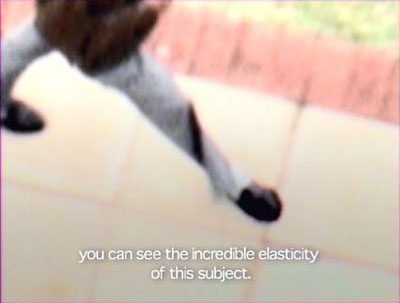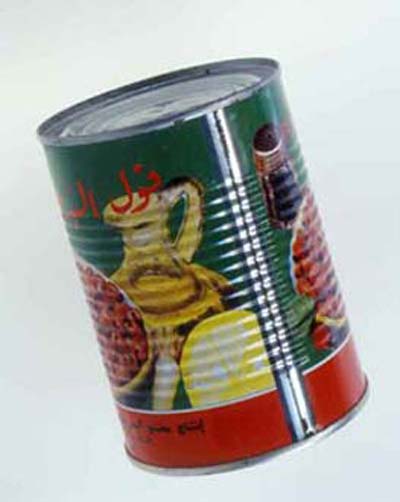
Sebastian Diaz Morales: "The Persecution of The White Car"
2001, video, 25', digital video on dvd, edition of 5
Sebastian Diaz Morales
The Apocalyptic Man
Jean-Luc Moulène
Documents/Produits de Palestine
Click for English text
Mit der Ausstellung von Sebastian Diaz Morales und neuen Arbeiten von Jean-Luc Moulène zeigen wir zwei äusserst unterschiedliche Ansätze, sich mit der direkten Ausdruckskraft des Bildes auseinandersetzen. Einmal als Möglichkeit, subjektive Erfahrungen in ihrem komplexen Kontext von Erinnerung und Veränderung zu vermitteln, oder als subtile, fast verborgene Kodierungen, die auf kulturelle und soziale Störfelder verweisen.
Die Werke von Sebastian Diaz Morales wurden bisher hauptsächlich auf Film- und Videofestivals gezeigt. In seiner ersten Ausstellung in Berlin zeigen wir drei Kurzfilme: "The Persecution of the White Car", 2001, "One Year later", 2001 und seine neue Arbeit "The Apocalyptic Man", 2002. Der Eindruck, den jede dieser Arbeiten hinterlässt, erwächst aus der Fähigkeit von Diaz Morales mit den poetischen wie experimentellen Möglichkeiten des Bildes gleichermassen zu spielen. Aus improvisierten und intuitiven Ansätzen entwickelt er beim Montieren der Filme eine sinnvolle und organisierte Bildsprache. Auf beeindruckende Art gehen dabei die verschiedensten Parameter unserer Wahrnehmung in eine nahezu barocke Synthese ein, Realität und Fiktion, Gegenwart, Vergangenheit und Erinnerung, Erzählung und Abstraktion.
In "The Apocalyptic Man", gedreht in Guanajuato (Mexico) und basierend auf dem Roman "Los siete locos" des argentinischen Schriftstellers Roberto Arlt, wird die Bildsprache durch kulturelle Symbole erweitert.

Jean-Luc Moulène: "02 08 11 Fèves", 2002
cibachrome photography, 40 cm x 50 cm
edition of 5
Mit "Documents/Produits de Palestine", führt Jean-Luc Moulène die visuelle Strategie seiner vorangegangenen Fotoreihe "Trente-neuf objets de grève" fort. Es sind "Dokumente" im Sinne von Untersuchungen. Wo liegen die verschiedenen Bedeutungsebenen eines Bildes und wie werden sie durch kritische Beobachtung oder Assoziation sowohl aufgedeckt als auch erzeugt? Auf subtile und scharfe Art brechen Moulènes Fotografien die Werbeästhetik, an die sie formal angelehnt sind. In der gleichen einfachen Logik und Direktheit, die dort auf Verlangen und moralische Akzeptanz zielen, sehen wir Tomatenpaste oder Olivenöl. Zurückgesetzt in ihren sozialen und politischen Kontext wundert man sich, wie viel mehr die Objekte doch eigentlich erzählen.
Ausstellungsdauer: 19.10.2002 - 18.1.2003
Oeffnungszeiten: Di-Sa 11 - 18 Uhr
Galerie carlier | gebauer
Holzmarktstrasse 15-18, Bogen 51/52
D-10179 Berlin
Telefon +49 30 280 81 10
Fax +49 30 280 81 09
E-Mail office@carliergebauer.com
www.carliergebauer.com
Sebastian Diaz Morales
The Apocalyptic Man
Jean-Luc Moulène
Documents/Products of Palestine
With the exhibition of Sebastian Diaz Morales (Comodoro Rivadavia, Argentina, 1974) and new works of Jean-Luc Moulène (Reims, France, 1955), we are dealing with two very different ways of reflecting upon the expressive power of the image, either as source to convey subjective experiences linked to memory, or as subtle, almost hidden codifications linked to cultural and social tensions.
Up to this point, the productions of Sebastian Diaz Morales have been seen essentially in festivals of independent films or in video programs. In his first show in Berlin, we now have the opportunity to see three of his most impressive short films: "The Persecution of the White Car", 2001, "One Year later", 2001 and his latest piece "The Apocalyptic Man", 2002. The impact produced by each of these works is very linked to Diaz Morales' ability to play with the poetic and experimental potential of the image, as well as with its capacity to synthesize, in an almost baroque way, reality and fiction, present and past, the narrative and abstract aspects that characterize our perception. During the editing of these films, his improvised and intuitive working method turns into a meaningful, structured language. In "The Apocalyptic Man", filmed in Guanajuato (México) and based on the novel of the Argentinian writer Roberto Arlt "Los siete locos", the image is also loaded with cultural symbols.
With "Documents/Products of Palestine", Jean-Luc Moulène continues the visual strategies that he so successfully developed in his previous series of photographs "Trente-neuf objets de grève". These new thirteen "documents" of Palestine are, in the broadest sense, investigations of the different levels of meaning hidden in an image and how this meaning can be unveiled through association, critical observation and distance. Formally related to advertising, Moulène's photographs break in a very subtle and sharp manner, the logic of simplicity and directness that is generally used in the commercial world to make their products desirable and morally acceptable. In this sense we are not looking at tins of tomato paste or bottles of olive oil, but rather at symbolic objects charged with social and political messages..
|

